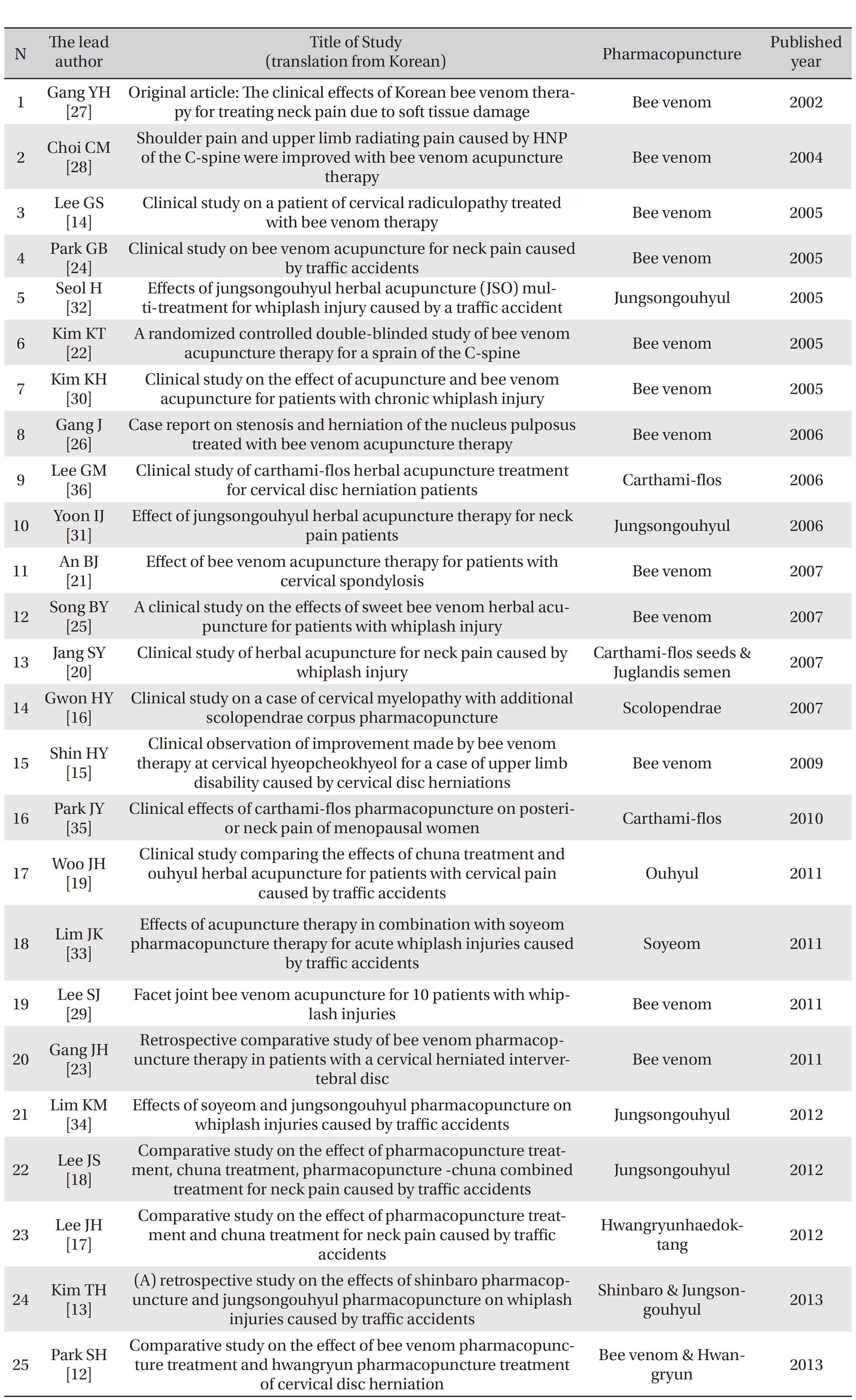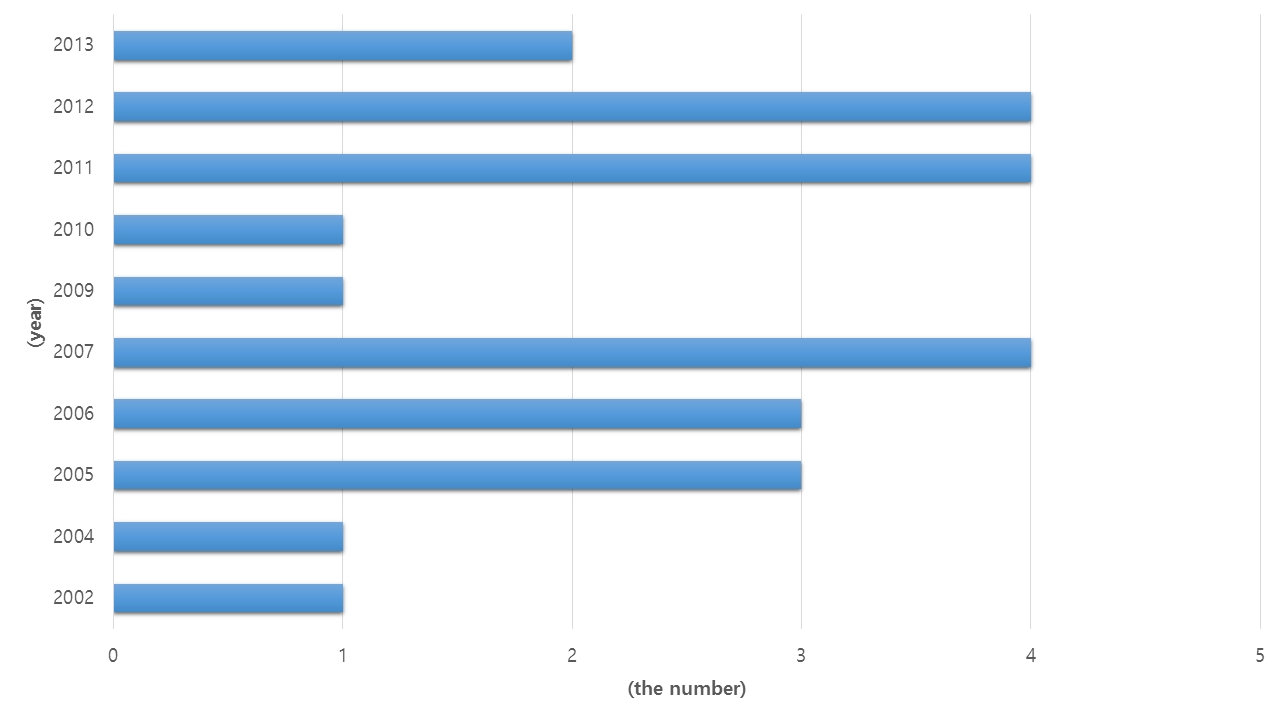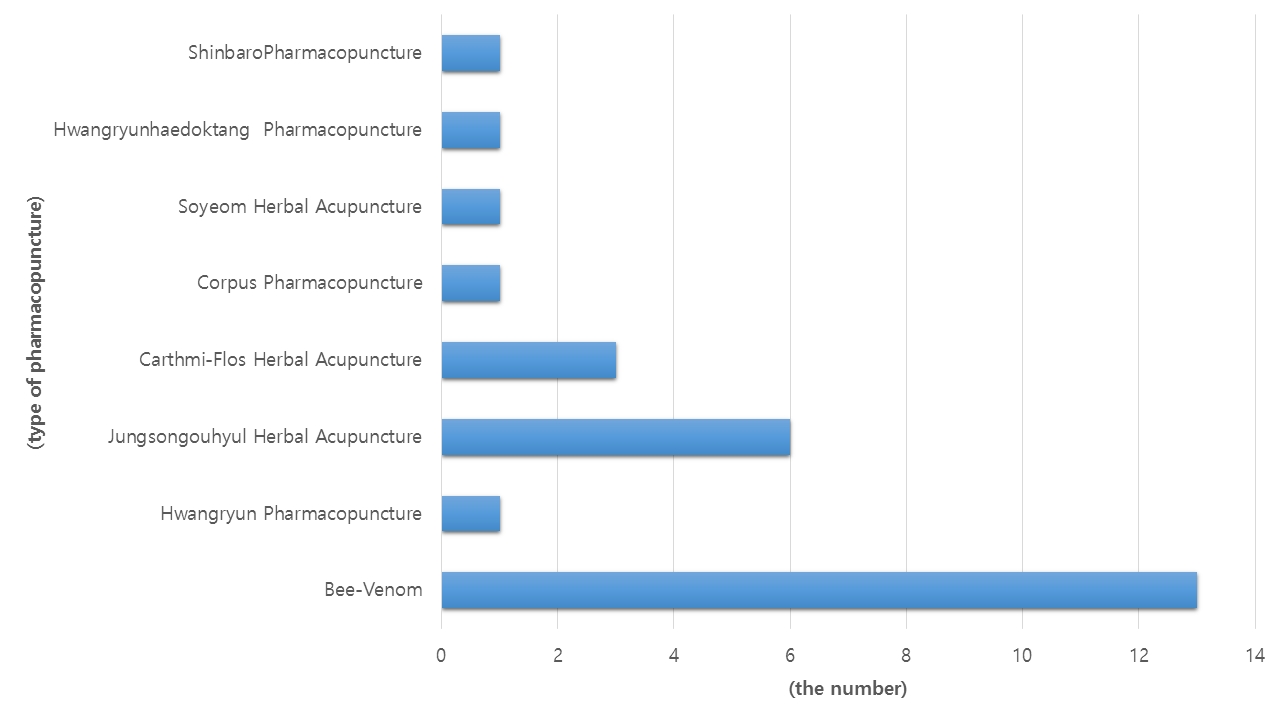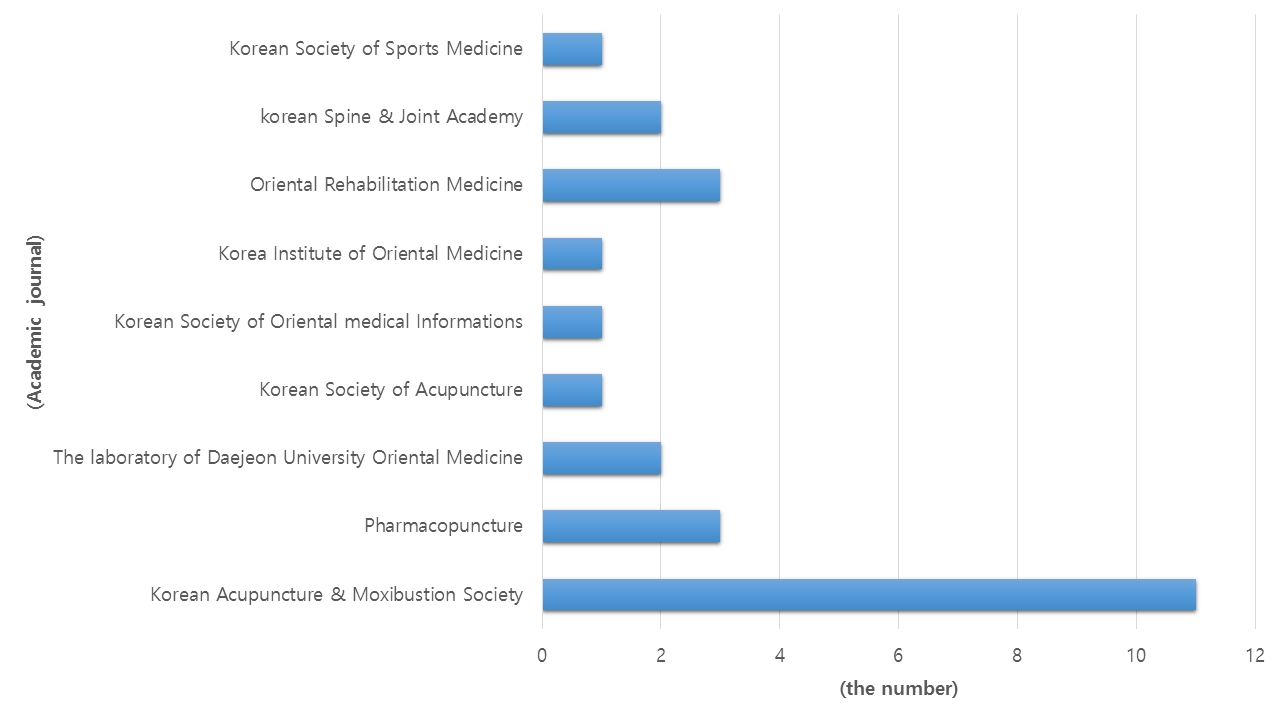



The purpose of this study is to analyze trends in domestic studies on pharmacopuncture therapy for treating cervical disease.
This study was carried out on original copies and abstracts of theses listed in databases or published until July 2014. The search was made on the Oriental medicine Advanced Searching Integrated System (OASIS) the National Digital Science Library (NDSL), and the Korean traditional knowledge portal. Search words were ‘pain on cervical spine’, ‘cervical pain’, ‘ruptured cervical disk’, ‘cervical disc disorder’, ‘stiffness of the neck’, ‘cervical disk’, ‘whiplash injury’, ‘cervicalgia’, ‘posterior cervical pain’, ‘neck disability’, ‘Herniated Nucleus Pulposus (HNP)’, and ‘Herniated Intervertebral Disc (HIVD)’.
Twenty-five clinical theses related to pharmacopuncture were selected and were analyzed by year according to the type of pharmacopuncture used, the academic journal in which the publication appeared, and the effect of pharmacopuncture therapy.
The significant conclusions are as follows: (1) Pharmacopunctures used for cervical pain were Bee venom pharmacopuncture, Carthami-flos pharmacopuncture, Scolopendra pharmacopuncture, Ouhyul pharmacopuncturen, Hwangryun pharmacopuncture, Corpus pharmacopuncture, Soyeom pharmacopuncture, Hwangryunhaedoktang pharmacopuncture, Shinbaro phamacopuncture. (2) Randomized controlled trials showed that pharmacopuncture therapy combined with other methods was more effective. (3) In the past, studies oriented toward Bee venom pharmacopuncture were actively pursued, but the number of studies on various other types of pharmacopuncture gradually began to increase. (4) For treating a patient with cervical pain, the type of pharmacopuncture to be used should be selected based on the cause of the disease and the patient’s condition.
Cervical pain means that the collum or regio occipitalis, a muscle, or a muscle and a blood vessel inside the neck are pulled or that pain is felt such areas. In most cases, when a patient moves his or her neck towards a certain direction, pain appears, limiting in the neck’s movement, and pressure pain appears on the collum [1]. Cervical pain in Oriental medicine is categorized as stiffness of the neck, headache, pain caused by stiffness, pain caused by stiffness of the neck, paresthesia, etc. The causes are fatigue damage, stress, the aftereffect of wind and moiteur, congenital deformation, trauma, external contraction, etc., which lead to the collateral meridian interruption and interruptions in the circulation of energy and blood [2].
Cervical pain in Western medicine is associated with a ruptured cervical disk, cervical spine osteoarthritis, cervical spondylosis, a spinal cord tumor, Torticollis, damage to the cervical muscle and tendon, a cervical sprain, neurogenic muscle tone on a cervical area, etc. [3, 4]. Pharmacopuncture therapy is a new form of therapy derived from the conjunction of meridian studies theory and herbal medicine theory. Meridian studies theory includes therapy to treat disease by controlling the functioning of the meridian system through acupuncture. Pharmacopuncture theory includes therapy to treat disease by using the efficacy of herbal medicine [5]. Since pharmacopuncture therapy was first introduced to Korea in 1960s, it has been frequently used clinically and is becoming a common therapy in Oriental medicine. Because pharmacopuncture therapy has been applied as a clinical treatment for some 40 years, studies on it have progressed in a variety of ways, and the results of many studies are becoming grounds for applying pharmacopuncture therapy as a clinical treatment [6, 7].
Recently, a number of studies about pharmacopuncture therapy have been done. Studies by Han
Objects for search were original copies and abstracts of theses listed on a database or published until July 2014. The search was made on the Oriental medicine Advanced Searching Integrated System (OASIS), the National Digital Science Library (NDSL), and the Korean traditional knowledge portal. Search words were classified according to symptom and disease. The words concerned with symptom were ‘pain on cervical spine’, ‘cervical pain’, ‘stiffness of the neck’, ‘posterior cervical pain’, and ‘neck disability’, and those concerned with disease were ‘cervical disk’, ‘whiplash injury’, ‘cervicalgia’, ‘Herniated Nucleus Pulposus (HNP)’, and ‘Herniated Intervertebral Disc (HIVD)’, ‘ruptured cervical disk’, and ‘cervical disc disorder’. These words were selected so that we could find theses involving patient groups undergoing Korean medicine treatments for cervical pain.
The author selected these on research involving pharmacopuncture therapy for cervical spine disease from among theses released in Korea. After the authors had selected or excluded specific theses independently, the decision whether or not to include a thesis was made by the entire research staff. Data extraction was performed by the authors. Such extraction was centered on the type of pharmacopuncture, the related disease and symptoms, the treatment’s effectiveness, the publication year.
The number of reports in the literature that were searched by using the above method totaled 1594. Among them, 222 were selected; 511 repeated reports and 861 theses that were not related to cervical disease were excluded. Finally, 25 clinical theses related to pharmacopuncture were selected (Table 1) Chronologically, these were released as follows: 1 thesis in 2002, 1 in 2004, 3 in 2005, 3 in 2006, 4 in 2007, 1 in 2009, 1 in 2010, 4 in 2011, 4 in 2012, and 2 in 2013 (Fig 1).
Among the 25 selected theses, 13 used Bee venom pharmacopuncture, among which a study by Park
Among the 25 selected theses, 11 came from the Korean Acupuncture & Moxibustion Society, 3 came from the Journal of the Pharmacopuncture Institute, and 3 came from the Journal of the Korean Academy of Oriental Rehabilitation Medicine. In addition, two each came from the Institute of Oriental Medicine Studies of Daejeon University and the Association of Spine & Joint Korean Medicine, and 1 each came from the Korean Journal of Acupuncture, the Korean Association of Oriental Medicine Information, the Korea Institute of Oriental Medicine, and the Journal of the Korean Association of Sports Oriental Medicine (Fig 3).
[Table. 1] List of selected clinical studies on post neck pain in Korean medicine

List of selected clinical studies on post neck pain in Korean medicine
Each thesis was analyzed for the effect of pharmacopuncture therapy in treating cervical pain. The studies by Lee
The study by Lee
In a study of Bee venom pharmacopuncture by Gang
In a study by Park
In the studies by Yoon [31] and Seol
As a result of analyzing clinical theses involving the use of pharmacopuncture for treating diseases in cervical area according to the type of pharmacopuncture used by publication year, 9 out of the 13 clinical theses related to pharmacopuncture released before 2007 were theses involving the use of Bee venom pharmacopuncture. However, after 2007, of the 12 clinical theses involving the use of pharmacopuncture to treat cervical pain, only 4 used Bee venom pharmacopuncture. This shows that the type of pharmacopuncture is changing from Bee venom pharmacopuncture to Ouhyul pharmacopuncture, Carthami-flos pharmacopuncture, Hwangryunhaedok-tang pharmacopuncture, etc.
These days, many people complain of cervical pain caused by excessive job, stress, etc. Thus, it has become necessary to actively study about the treatment of cervical pain in Oriental medicine. In Oriental medicine, many treatments are used for cervical pain: for example, acupuncture therapy, herbal medicine, pharmacopuncture, chuna manual medicine therapy, electroacupuncture. Among them, pharmacopuncture therapy combines existing meridian channel theory with the efficacy of herbal medicine. As efficacy of pharmacopuncture therapy is excellent, its use is on the rise, and the types of pharmacopuncture are increasing. For those reasons, Lee
Objects for search were original copies and abstracts of theses listed in a database or published until July 2014. The search was made on OASIS the NDSL, and the Korean traditional knowledge portal. Search words were connected with cervical pain disease and symptoms. The number of reports in the literature that were searched by using the above method totaled 1594. Finally, 25 clinical theses related to pharmacopuncture were selected. Among the 25 selected theses, 13 (52%) used Bee venom pharmacopuncture. Thus, clinical studies using Bee venom pharmacopuncture to treat cervical disease were in a slight majority.
By academic journal in which the selected theses were published, 11 came from the Korean Acupuncture & Moxibustion Society, which accounted for 44% of the total and ranked No. 1, and 3 each came from the Journal of the Korean pharmacopuncture Institute and the Journal of the Korean Academy of Oriental Rehabilitation Medicine, which accounted for 12% of the total and ranked No. 2.
Also, among the 25 selected theses, 16 involved RCTs. Of these 16, 8 compared a pharmacopuncture group to an acupuncture combined with pharmacopuncture group, and the acupuncture combined with pharmacopuncture group showed a better result than the pharmacopuncture group. In the study by Kim
As a result of examining the recent trend in pharmacopuncture used to treat disease in the cervical area, we found that the main study theme before 2008 was Bee venom pharmacopuncture. However, from 2008, the type of pharmacopuncture has been changing from Bee venom pharmacopuncture to Ouhyul pharmacopuncture, Carthami- flos pharmacopuncture, Hwangryunhaedok-tang pharmacopuncture, etc. This means that clinical researchers are highly interested in various types of pharmacopuncture, but still there are not enough studies to confirm the effect pharmacopuncture. Thus, in the future, many studies are needed to identify the most effective pharmacopuncture treatments, along with their type, volume, procedure region, and number of treatments, and it is out hope that many such reports actually be published.
By analyzing theses related to cervical pain published in journals of academic institutes for Korean medicine, we were able to draw the following conclusions:
1. Pharmacopunctures used for cervical pain were pharmacopunctures used for cervical pain were Bee venom pharmacopuncture, Carthami-flos pharmacopuncture, Scolopendra pharmacopuncture, Ouhyul pharmacopuncturen, Hwangryun pharmacopuncture, Corpus pharmacopuncture, Soyeom pharmacopuncture, Hwangryunhaedoktang pharmacopuncture, Shinbaro phamacopuncture.
2. As a result of a RCT study, a group treated with pharmacopuncture therapy combined with another method showed effective results.
3. In the past, Bee venom pharmacopuncture oriented studies were actively pursued, but the number of studies on various types of pharmacopuncture has been gradually increasing.
4. For treating a patient with cervical pain, the type of pharmacopuncture to be used should be selected based on the cause of the disease and the patient’s condition.



